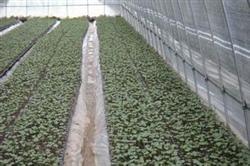Prevention and treatment of premature senescence of cotton in the middle and later stage

Cotton premature senescence refers to the phenomenon that cotton leaves are small, buds are few, even accompanied by diseases, cotton leaves fall off prematurely and cotton plants die at the best time of blooming and setting bolls. Premature senility is the main factor leading to the reduction of cotton production, with a yield reduction of more than 20%. It is very important for cotton production to find out the causes of premature senility and take corresponding countermeasures. First, the cause of premature senility is mainly caused by the physiological function disorder of cotton plant itself and the imbalance of nutrition supply and demand distribution. The causes of dysfunction are induced by adverse environmental conditions, disease factors, uncoordinated growth and development factors, and the result of comprehensive action of many factors. Second, the prevention and cure countermeasure cotton premature senescence generally appears in the drought year, all has the premature senescence phenomenon in varying degrees. In the years with the phenomenon of premature senility, the temperature in the later stage is high and the light is sufficient. If we can comprehensively prevent and cure premature senility, we can still get a bumper harvest. (1) crop rotation and fertility rotation can improve the soil ecological environment of cotton fields, reduce the spread of germs and reduce diseases. In addition, straw returning to the field, increasing the application of organic fertilizer to improve soil structure, improve soil fertility, and reduce the premature senescence of cotton caused by soil environment. (2) strengthening the management of fertilizer and water on the basis of applying sufficient base fertilizer, topdressing before blooming in dry years, before flowering in normal years, and appropriate late topdressing in years with more Rain Water. 15 per mu was topdressing with 20 kg urea and 5 kg potassium chloride. The water demand is the highest in the flowering and boll stage, to avoid premature senescence caused by the hindrance of leaf development caused by water shortage, and to ensure that the cotton plant is not short of water in the bud stage, flower and boll stage and late boll setting stage. (3) the selection of suitable varieties should be based on local soil, water and fertilizer conditions according to the different characteristics of each variety. (4) to maintain roots and protect leaves to prevent premature senescence (1) for early cotton, especially plastic film cotton, in order to avoid premature inhibition of vegetative growth, resulting in plant dwarfism, short upper fruit branches and premature failure and death. Eight early buds of 6Mel can be removed in late June to strengthen the vegetative growth of roots and shoots, promote the establishment of harvest shelves, and facilitate the concentration of peaches and early autumn peaches. (2) to increase the application of potash fertilizer and improve the stress resistance of cotton plants, top fertilizer was applied in mid-August, 10 kg of urea per mu plus 0.2% potassium dihydrogen phosphate plus 1% urea, and foliar fertilizer was sprayed in mid-September, which could prolong the functional period of leaves and improve the physiological function of plants. delay senescence.
- Prev

How to control cotton falling peach
There are many reasons for the emergence rate of cotton, including the influence of weather on cotton maturity during last year's cotton harvest season and the appropriateness of cotton seedling raising technology. In terms of last year's climate, the weather during cotton harvest is generally good, and it is good for cotton seed maturity.
- Next

Interplanting cotton with spring cauliflower and summer lettuce
The real culprit of this headless cotton phenomenon is a pest called cotton thrips, which is the most serious pest in cotton fields, mainly tobacco thrips. The adults and nymphs of tobacco thrips are so small that they are difficult to see with the naked eye and can only be seen on the back of the leaves with a magnifying glass. It harms cotton seedlings in the way of adults or 1-or 2-year-old nymphs.
Related
- The first cup of black tea in spring, the flavor and history of tea gardens in Kenya, Africa
- The computer can not only choose potatoes, but also grow tea rice. AI will grow winter oolong tea champion.
- It is not only the inflated tea bitten by insects, but also engraved with the four seasons tea in Beipu.
- The Oriental Beauty Tea Festival in Zhuxian County takes the stage at the weekend to experience the plus-size feast of oil tea.
- & quot; Oriental Beauty Tea & Exploration of Emei in Hsinchu, the hometown of quot;
- The new variety of strawberry "Tainong 1" dessert is the first choice with mellow aroma. Crimson gorgeous
- History of Tea in Taiwan: from Wild Inner Mountain to Export Tea Garden
- Two types of Taiwan Oriental Beauty Black Tea won the British three-Star Award for Childhood Tea Xiang Zhang Jiaqi changed from pilot to champion tea maker.
- Banana species and varieties: the planting history of Taiwan Xianren banana and dwarf banana is long, is banana disease resistant?
- Coffee planting Technology: Qianjie Coffee from Seedling to harvesting

